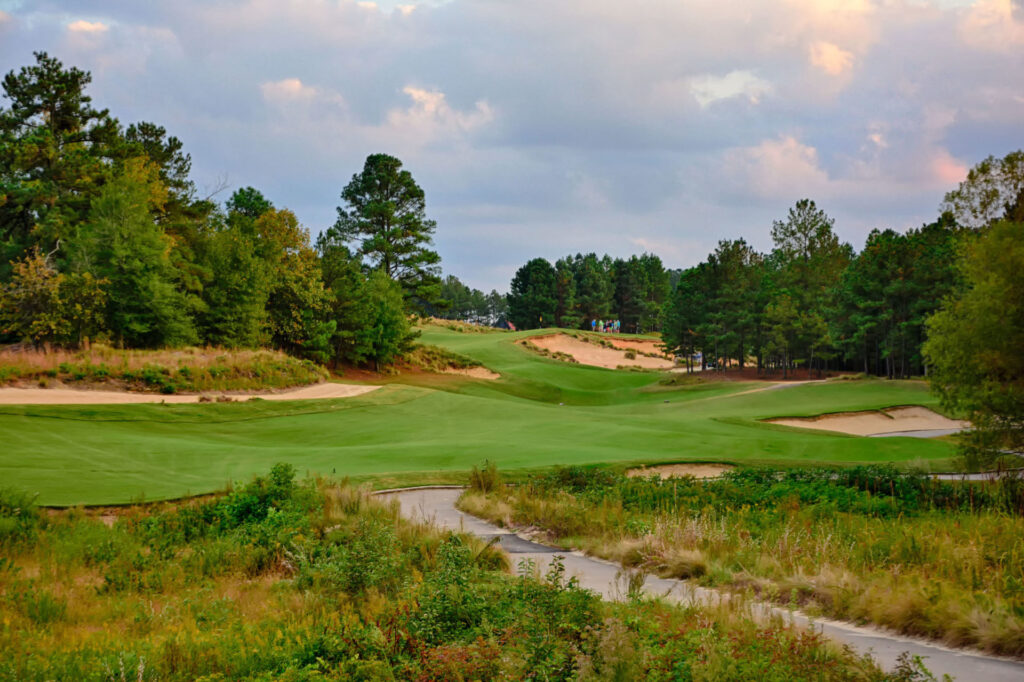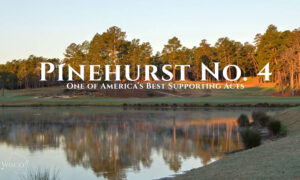There is an old saw in golf travel that goes, “Be careful playing golf courses with an animal in their name, and that includes John Daly’s Wicked Stick.”
All humor aside, the curse is real, much like not saying the name of That Scottish Play by Shakespeare in a theatre or at a concert. Rack your brain, search the lists, ask the Google machine and you’ll see it in print: precious few courses with animal names have high ratings or wide acclaim.
And so it was that anyone who went outgra to play some golf in North Carolina during PGA Championship week likely played a better golf course than the Tour pros did when they descended upon Charlotte for the 2025 golf season’s second major. Some may holler “BLASPHEMY,” but as the kids say, I have the receipts: Quail Hollow – a yearly PGA Tour stop and two-time PGA Championship venue – isn’t even near the top 10 best golf courses in North Carolina.
Years ago, in 2017 when the PGA Championship first came to Quail Hollow, we took an informal poll of about four dozen golf architects, golf design experts, and well-traveled players and asked them to list their top 10 courses in the state. Then we added up the scores. It was unscientific, to be sure, but even now, eight years later when we went back and loosely checked again with a similar crew, everyone still agreed with the list. And Quail Hollow was nowhere to be found.
One important reason? It’s still the same long, watery, center-line, boring, ‘80s era slog. By contrast, just consider the brilliant strategic designs of the ten courses listed in our informal top 10:
- Old Town Club, Wake Forest University, Winston-Salem, NC
- Pinehurst No. 2, Pinehurst, NC
- Pine Needles (which hosted two U.S. Women’s Opens)
- Wade Hampton (where the Great Smokeys meet the Blue Ridge)
- Tobacco Road (called “The Most Adventurous Golf Club in America”)
- Mid-Pines (which recently underwent a wildly successful restoration by Kyle Franz)
- Roaring Gap (Architect Donald Ross and developer Leonard Tufts’s summertime retreat from the heat of Pinehurst)
- The Dormie Club (the haute new course designed by Coore and Crenshaw)
- Grandfather Mountain (Ellis Maples’s masterpiece carved beneath the darkly frowning brow of the mighty mountain itself)
- Charlotte Country Club (a Ross which underwent a magnificent restoration by Ron Pritchard)
Cut to eight years later, and nothing has changed. Quail Hollow has neither improved as a golf course, nor have any of the designs listed above suffered any marked decline. Quite the opposite in fact; in most cases their legend grows. Most golfers consider North Carolina as one of the top five golf states in the union and, depending who you ask, it might even be top two or three. From the lapping waves of the Atlantic to the misty mountains of the west, North Carolina is a Louvre quality collection of some of the finest courses in the world, and many of them are public.
Yet North Carolina is also one of the cradles of American with strategic Golden Age designs standing sentinel next to instant classics/modern masterpieces. And now the state is also at the vanguard of movement back to old school architecture as many of its courses are showpieces for this generation’s Second Golden Age of Golf Course Architecture, setting trends in sustainability, conditioning, business model and, of course, design strategy.
OLD TOWN CLUB
Finally, the magazine rankings have started to reflect what we all saw years ago – Coore and Crenshaw’s jaw-dropping reimagination of the last course designed by Perry Maxwell’s is a stratospheric triumph. “Number 1 in North Carolina” the magazines trumpeted, and rightfully so. A golf course that both Ran Morrissett of Golf Magazine and Perry Maxwell biographer Chris Clouser agree was the last great course designed in the First Golden age of Golf Course Architecture, a bookend and a mile marker in the history of the craft of golf design.
Old Town’s renovation by Coore and Crenshaw was catapulted into the stratosphere of the rankings by shaving unsightly swaths of rough: instead, a whopping six fairways interconnect with one another and three others are adjacent. The course uses only bunkers, a stream, and the natural undulations of the fairways to define the playing corridors. A glorious double green at holes 8 and 17 was a masterstroke.
PINEHURST No. 2.
Pinehurst No. 2 was Donald Ross’s magnum opus. It’s held four epic U.S. Opens in a quarter-century, the 1936 PGA Championship, and the old North and South Open, a former major from long ago in golf’s Golden Age. Its crowned turtleback greens are as insidiously devious as any greens the world – easily on par with Winged Foot and Oakmont. They are a much smaller target than they appear from the fairway, and even the shortest putts are knee-knockers.
Moreover, its stately elegance and charm have been the gold standard in hospitality for near a century.
[Author’s Note: While none of the other Pinehurst Resort courses cracked the top 10, several of them are unquestionably strong and quality golf designs. One can question the price for some of the other selections, but No. 2 is a golf cultural imperative.]

TOBACCO ROAD
Called by Golf Magazine “The Most Adventurous Golf Course in America,” Mike Strantz’s Tobacco Road is the far edge of the golf map – terra incognita – a place spoken of in holy whispers among the cognoscenti. Wild, unapologetic, and sincere to the formative years of the game, Tobacco Road is completely unlike anything else in North Carolina, or anywhere else, for that matter.
And that’s why fans adore it.
What set Strantz apart at Tobacco Road and elsewhere in his catalog was his choosing to design golf holes directly into the teeth of the natural features and for using the Doctrine of Deception off the tee. Instead of framing the hole and spoon-feeding the golfer the shot required to be played, Strantz lets the golfer decide how much danger to challenge off the tee and succeed or fail depending on how well they both planned the shot and executed it.
Bigger isn’t better. Harder isn’t better. Richer isn’t better. Smarter is better…and more fun.
THE REST
Pine Needles and Mid-Pines are next-door neighbors and usually played in tandem. Pine Needles (which hosted two U.S. Women’s Opens) is generally regarded as the more difficult and prettier of the two, but no less a personage than Ran Morrissett, chief muckety-muck of golf design and travel at Golf Magazine, sang whole arias about how wonderful the renovation of Mid-Pines by Kyle Franz was. For close to a century countless northeast college golf teams would take spring break in the old dorms at Mid-Pines and play both courses for a week.
The fortunate ones made the travel team. The others left with broken dreams.
Donald Ross has two more courses on the list besides Pinehurst No. 2. Charlotte Country Club underwent a wildly successful restoration by Colorado golf architect Ron Prichard, so Quail Hollow is regarded by many as only the second-best course in its own city. And Roaring Gap, Donald Ross and developer Leonard Tufts’s summertime retreat from the heat of Pinehurst, is also garnering rave reviews from all across the golf industry, including golf design expert Dunlop White, who waxed poetically about it to Your Author on many occasions.
“Everyone has to see it,” he beamed. “It’s absolutely majestic.”

So are Wade Hampton and Grandfather Mountain, the former being Tom Fazio’s idyllic, low country design, the latter being Ellis Maples’s masterpiece traversing precipitously beneath the darkly frowning brow of the mighty mountain itself. Indeed, from the Outer Banks to the Tennessee border, few states can match North Carolina for both quantity and quality of golf. The only things that surpass that is the ardor and fervor of the golf fans that live there. They are North Carolina golf’s greatest treasure…among an embarrassment of riches.
When not reporting live from major sports championships or researching golf courses for design, value, and excitement, multiple award-winning sportswriter Jay Flemma is an entertainment, Internet, trademark, and banking lawyer from New York. His clients have been nominated for Grammy and Emmy awards, won a Sundance Film Festival Best Director award, performed on stage and screen, and designed pop art for museums and collectors. Twitter @JayGolfUSA

















